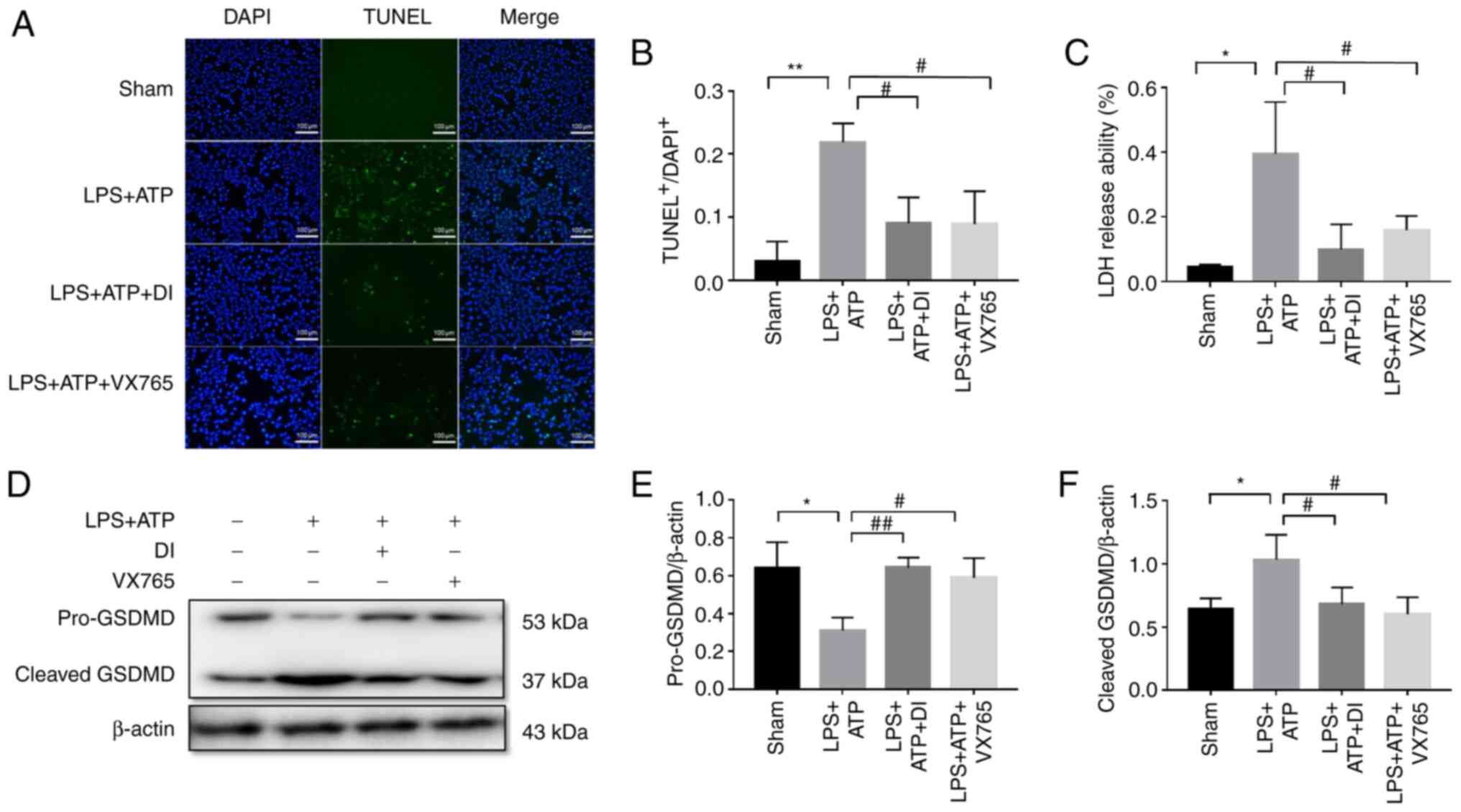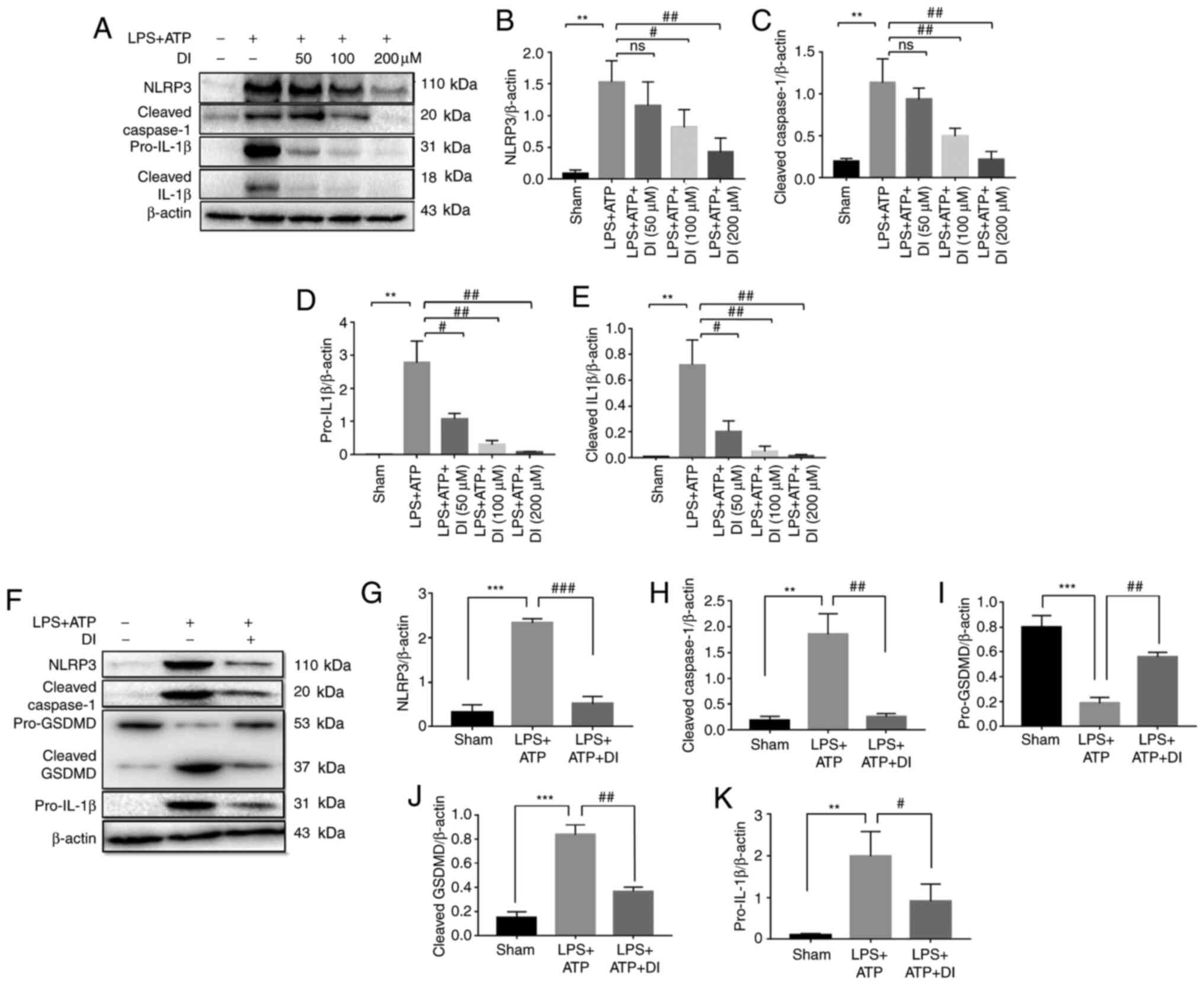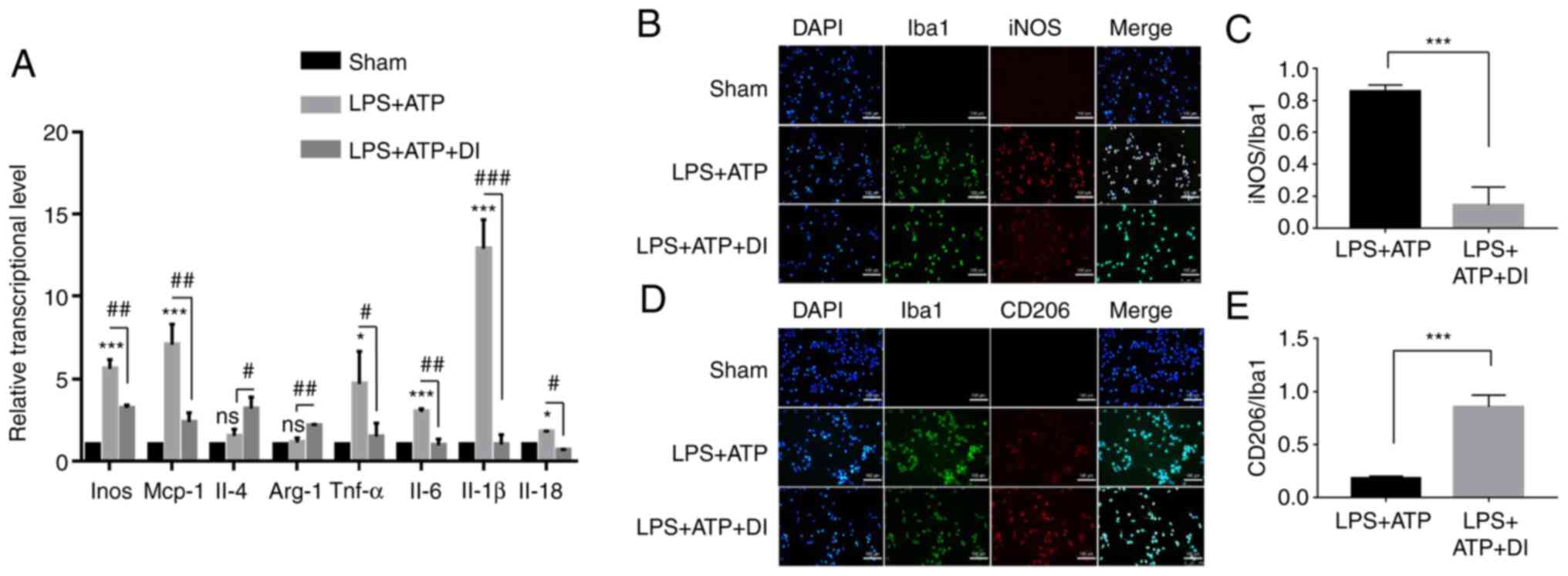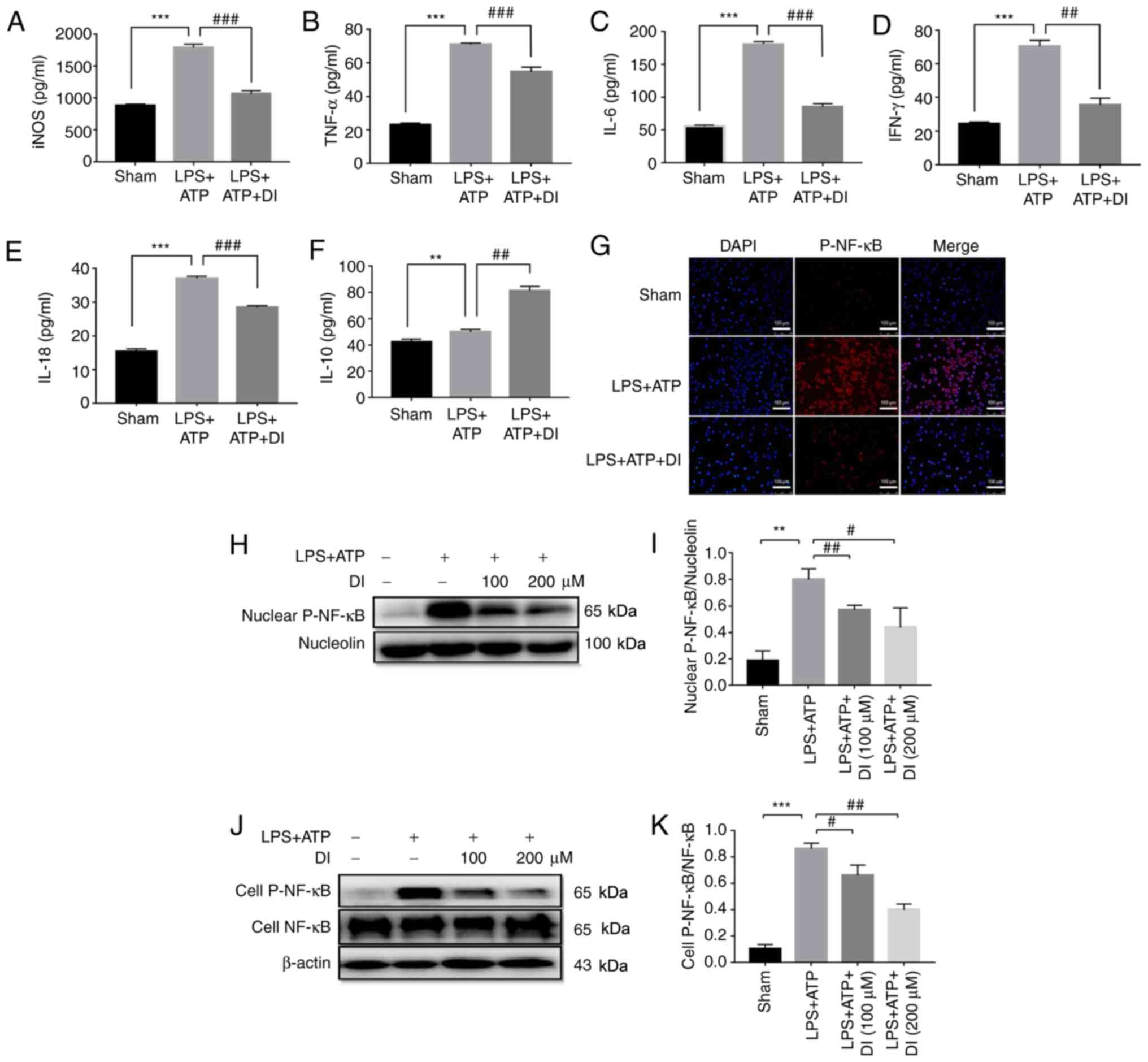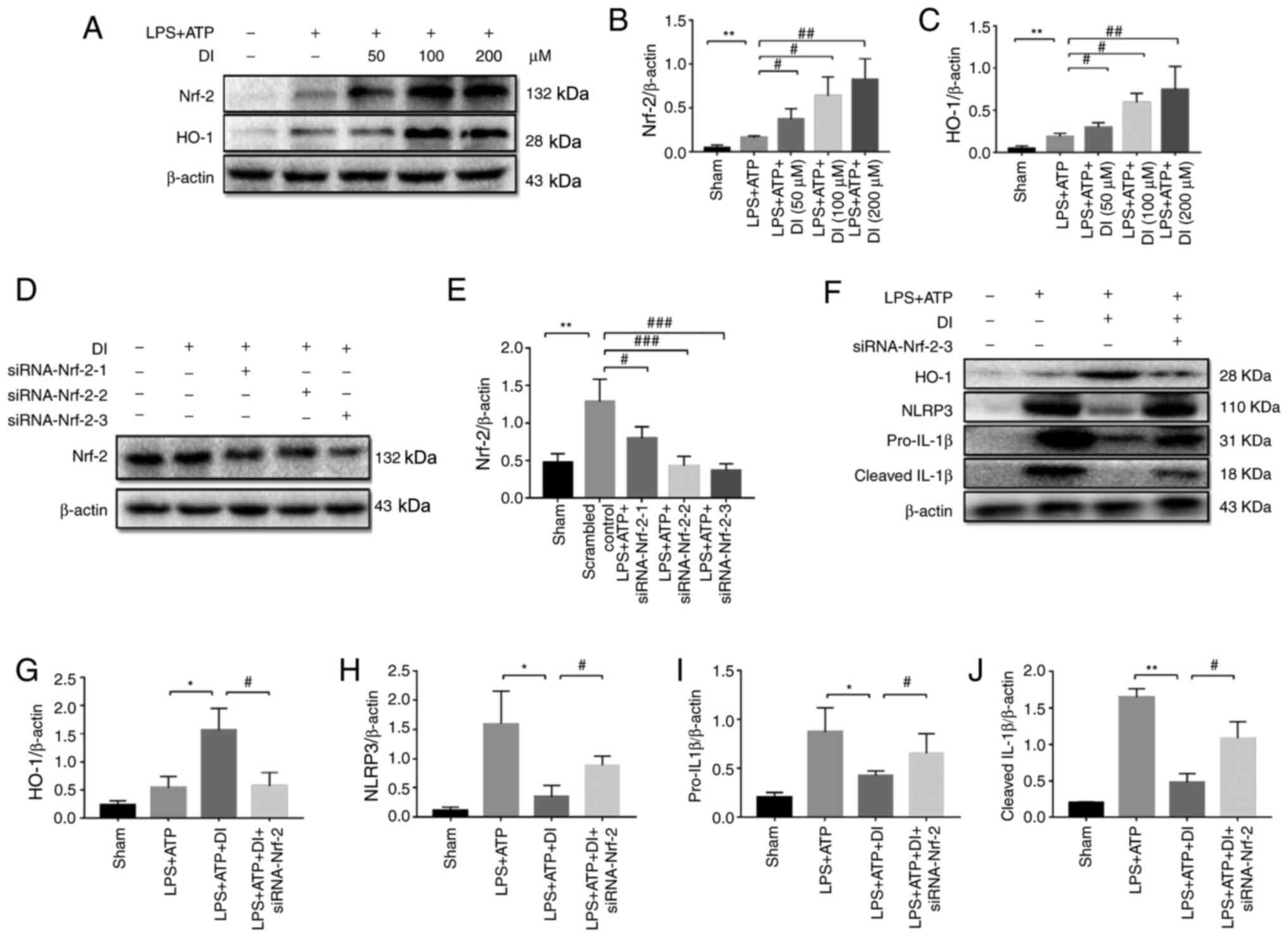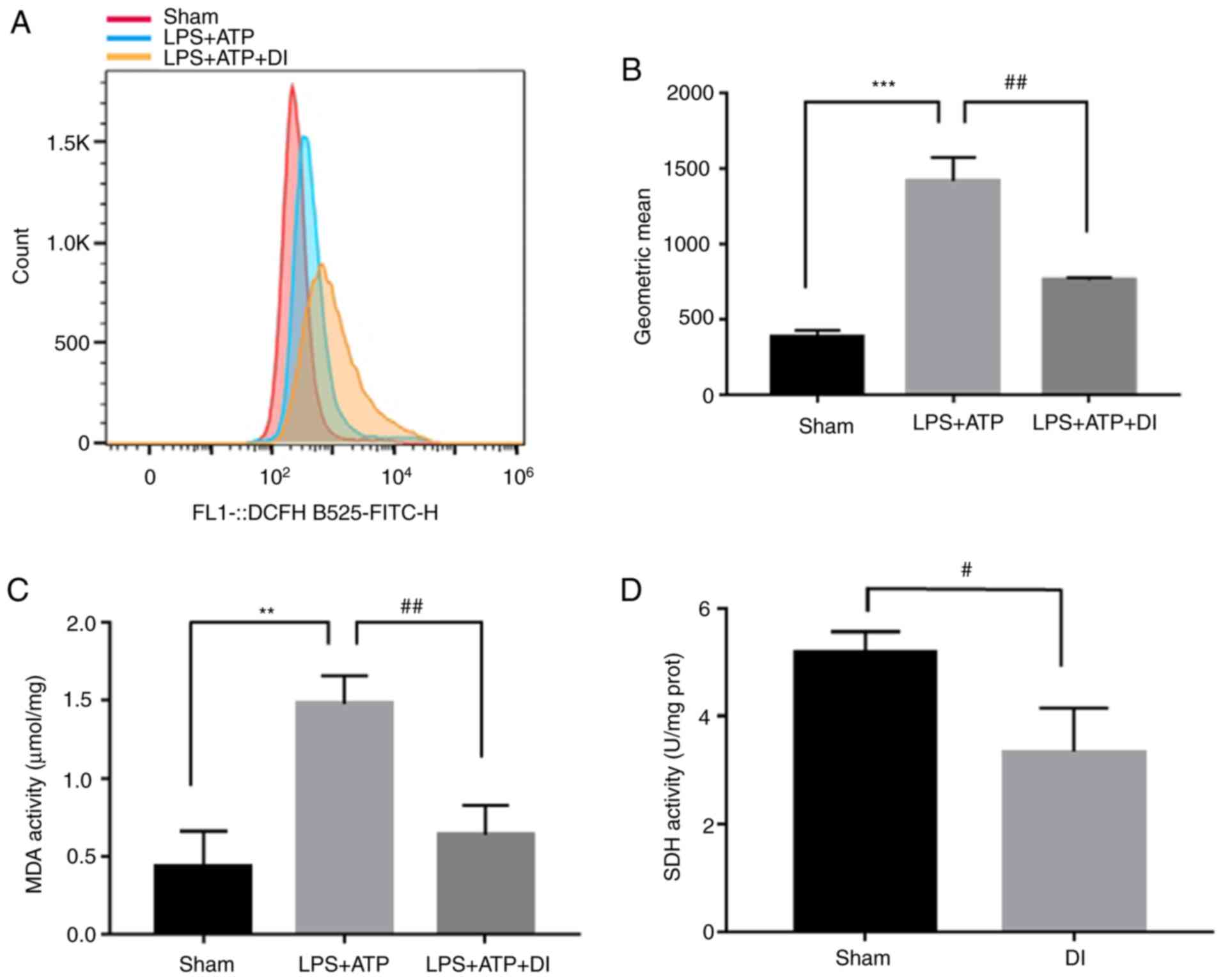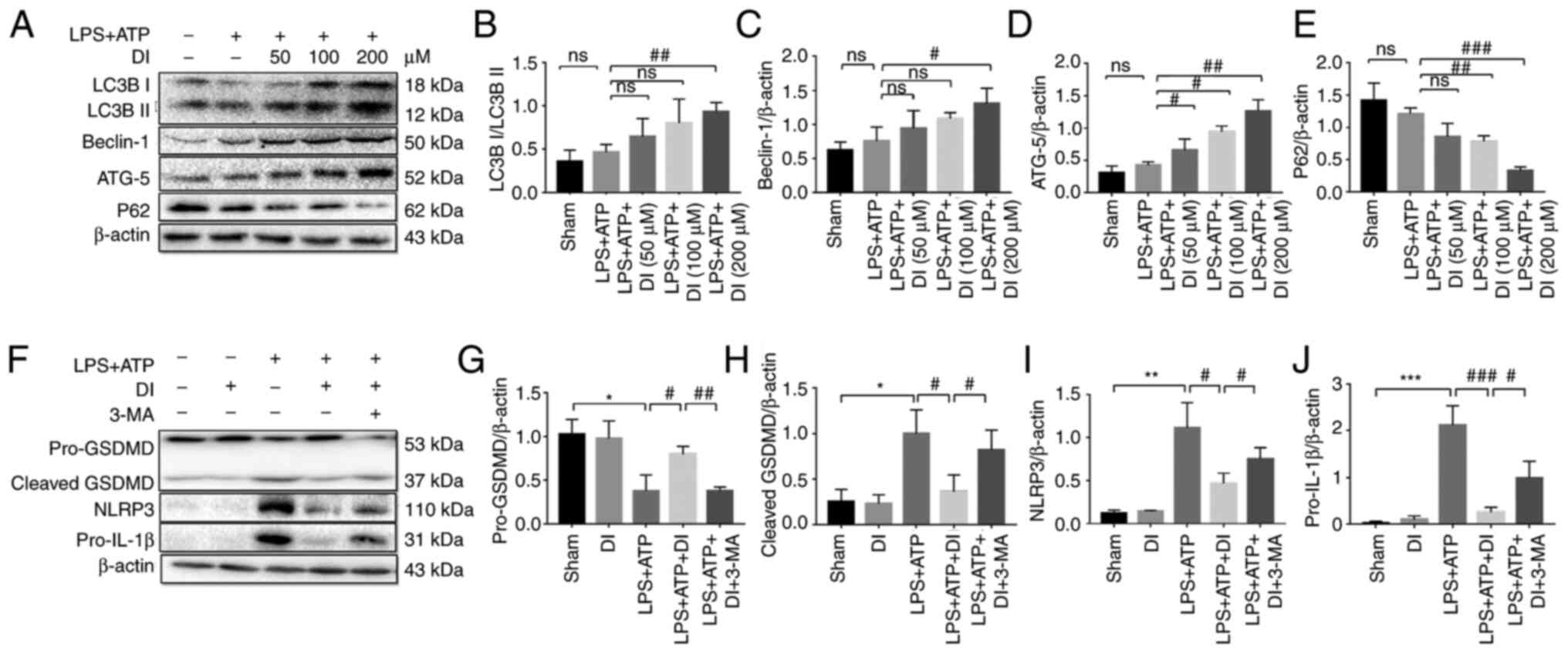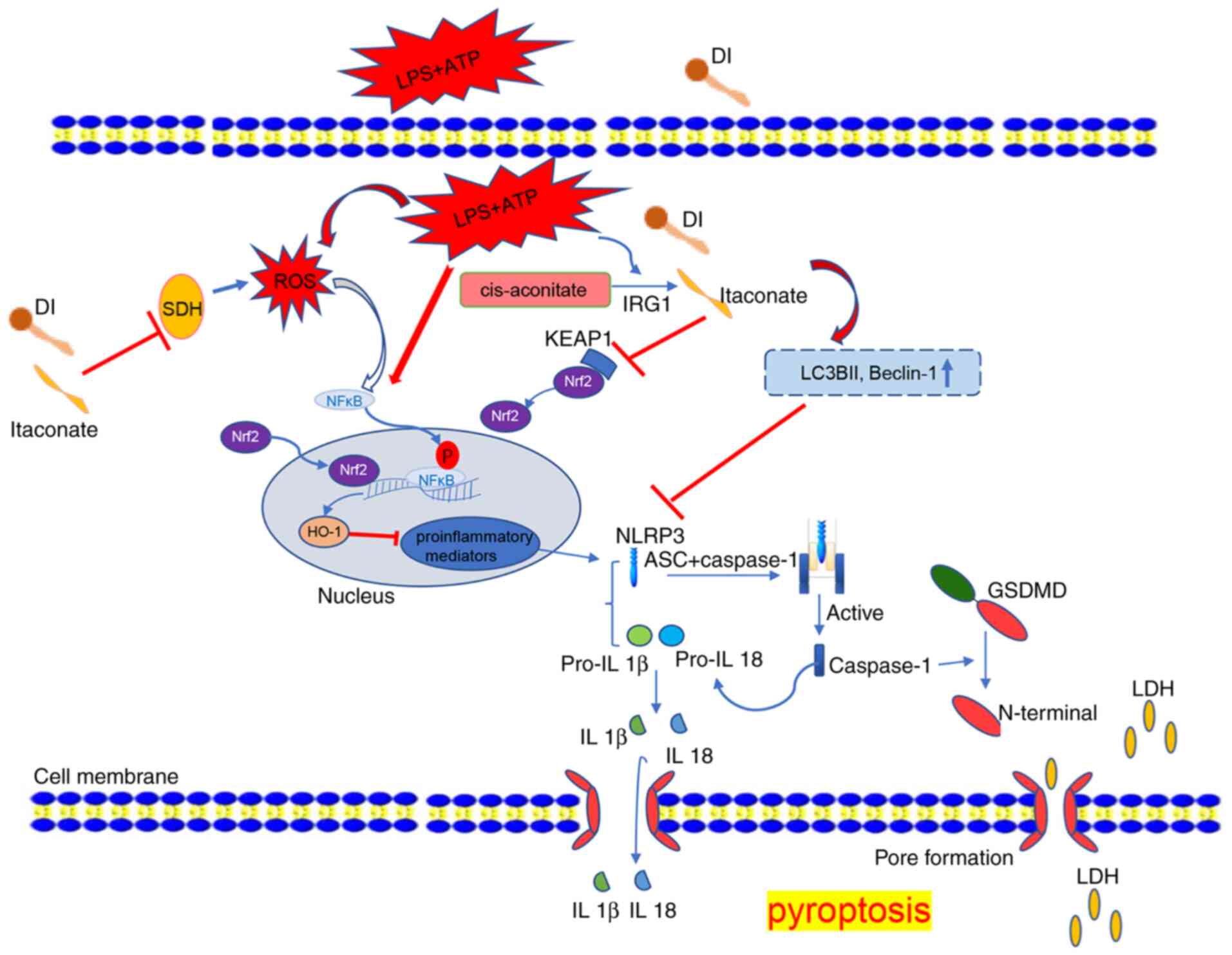|
1
|
Dheen ST, Kaur C and Ling EA: Microglial
activation and its implications in the brain diseases. Curr Med
Chem. 14:1189–1197. 2007. View Article : Google Scholar : PubMed/NCBI
|
|
2
|
Walter L and Neumann H: Role of microglia
in neuronal degeneration and regeneration. Semin Immunopathol.
31:513–525. 2009. View Article : Google Scholar : PubMed/NCBI
|
|
3
|
Hu X, Leak RK, Shi Y, Suenaga J, Gao Y,
Zheng P and Chen J: Microglial and macrophage polarization-new
prospects for brain repair. Nat Rev Neurol. 11:56–64. 2015.
View Article : Google Scholar : PubMed/NCBI
|
|
4
|
Lan X, Han X, Li Q, Yang QW and Wang J:
Modulators of microglial activation and polarization after
intracerebral haemorrhage. Nat Rev Neurol. 13:420–433. 2017.
View Article : Google Scholar : PubMed/NCBI
|
|
5
|
Lee E, Eo JC, Lee C and Yu JW: Distinct
features of brain-resident macrophages: Microglia and
non-parenchymal brain macrophages. Mol Cells. 44:281–291. 2021.
View Article : Google Scholar : PubMed/NCBI
|
|
6
|
Xiong XY, Liu L and Yang QW: Functions and
mechanisms of microglia/macrophages in neuroinflammation and
neurogenesis after stroke. Prog Neurobiol. 142:23–44. 2016.
View Article : Google Scholar : PubMed/NCBI
|
|
7
|
Mathur A, Hayward JA and Man SM: Molecular
mechanisms of inflammasome signaling. J Leukoc Biol. 103:233–257.
2018.PubMed/NCBI
|
|
8
|
Gritsenko A, Green JP, Brough D and
Lopez-Castejon G: Mechanisms of NLRP3 priming in inflammaging and
age related diseases. Cytokine Growth Factor Rev. 55:15–25. 2020.
View Article : Google Scholar : PubMed/NCBI
|
|
9
|
Wang L and Hauenstein AV: The NLRP3
inflammasome: Mechanism of action, role in disease and therapies.
Mol Aspects Med. 76:1008892020. View Article : Google Scholar : PubMed/NCBI
|
|
10
|
Liu YG, Chen JK, Zhang ZT, Ma XJ, Chen YC,
Du XM, Liu H, Zong Y and Lu GC: NLRP3 inflammasome activation
mediates radiation-induced pyroptosis in bone marrow-derived
macrophages. Cell Death Dis. 8:e25792017. View Article : Google Scholar : PubMed/NCBI
|
|
11
|
Sorbara MT and Girardin SE: Mitochondrial
ROS fuel the inflammasome. Cell Res. 21:558–560. 2011. View Article : Google Scholar : PubMed/NCBI
|
|
12
|
Gurung P, Lukens JR and Kanneganti TD:
Mitochondria: Diversity in the regulation of the NLRP3
inflammasome. Trends Mol Med. 21:193–201. 2015. View Article : Google Scholar : PubMed/NCBI
|
|
13
|
Shi J, Gao W and Shao F: Pyroptosis:
Gasdermin-mediated programmed necrotic cell death. Trends Biochem
Sci. 42:245–254. 2017. View Article : Google Scholar : PubMed/NCBI
|
|
14
|
Fink SL and Cookson BT: Apoptosis,
pyroptosis, and necrosis: Mechanistic description of dead and dying
eukaryotic cells. Infect Immun. 73:1907–1916. 2005. View Article : Google Scholar : PubMed/NCBI
|
|
15
|
Sarhan M, Land WG, Tonnus W, Hugo CP and
Linkermann A: Origin and consequences of necroinflammation. Physiol
Rev. 98:727–780. 2018. View Article : Google Scholar : PubMed/NCBI
|
|
16
|
Tang D, Kang R, Berghe TV, Vandenabeele P
and Kroemer G: The molecular machinery of regulated cell death.
Cell Res. 29:347–364. 2019. View Article : Google Scholar : PubMed/NCBI
|
|
17
|
He Y, Hara H and Nunez G: Mechanism and
regulation of NLRP3 inflammasome activation. Trends Biochem Sci.
41:1012–1021. 2016. View Article : Google Scholar : PubMed/NCBI
|
|
18
|
Weigt SS, Palchevskiy V and Belperio JA:
Inflammasomes and IL-1 biology in the pathogenesis of allograft
dysfunction. J Clin Invest. 127:2022–2029. 2017. View Article : Google Scholar : PubMed/NCBI
|
|
19
|
Kovacs SB and Miao EA: Gasdermins:
Effectors of pyroptosis. Trends Cell Biol. 27:673–684. 2017.
View Article : Google Scholar : PubMed/NCBI
|
|
20
|
Liu X, Zhang Z, Ruan J, Pan Y, Magupalli
VG, Wu H and Lieberman J: Inflammasome-activated gasdermin D causes
pyroptosis by forming membrane pores. Nature. 535:153–158. 2016.
View Article : Google Scholar : PubMed/NCBI
|
|
21
|
Dempsey LA: Immunoregulatory itaconate.
Nat Immunol. 19:5112018. View Article : Google Scholar
|
|
22
|
Yu XH, Zhang DW, Zheng XL and Tang CK:
Itaconate: An emerging determinant of inflammation in activated
macrophages. Immunol Cell Biol. 97:134–141. 2019.PubMed/NCBI
|
|
23
|
Lampropoulou V, Sergushichev A,
Bambouskova M, Nair S, Vincent EE, Loginicheva E,
Cervantes-Barragan L, Ma X, Huang SC, Griss T, et al: Itaconate
links inhibition of succinate dehydrogenase with macrophage
metabolic remodeling and regulation of inflammation. Cell Metab.
24:158–166. 2016. View Article : Google Scholar : PubMed/NCBI
|
|
24
|
Bordon Y: Itaconate charges down
inflammation. Nat Rev Immunol. 18:360–361. 2018. View Article : Google Scholar : PubMed/NCBI
|
|
25
|
Cordes T, Wallace M, Michelucci A,
Divakaruni AS, Sapcariu SC, Sousa C, Koseki H, Cabrales P, Murphy
AN, Hiller K and Metallo CM: Immunoresponsive gene 1 and itaconate
inhibit succinate dehydrogenase to modulate intracellular succinate
levels. J Biol Chem. 291:14274–14284. 2016. View Article : Google Scholar : PubMed/NCBI
|
|
26
|
Zhao C, Jiang P, He Z, Yuan X, Guo J, Li
Y, Hu X, Cao Y, Fu Y and Zhang N: Dimethyl itaconate protects
against lippolysacchride-induced mastitis in mice by activating
MAPKs and Nrf2 and inhibiting NF-kappaB signaling pathways. Microb
Pathog. 133:1035412019. View Article : Google Scholar : PubMed/NCBI
|
|
27
|
Shan Q, Li X, Zheng M, Lin X, Lu G, Su D
and Lu X: Protective effects of dimethyl itaconate in mice acute
cardiotoxicity induced by doxorubicin. Biochem Biophys Res Commun.
517:538–544. 2019. View Article : Google Scholar : PubMed/NCBI
|
|
28
|
Mills EL, Ryan DG, Prag HA, Dikovskaya D,
Menon D, Zaslona Z, Jedrychowski MP, Costa ASH, Higgins M, Hams E,
et al: Itaconate is an anti-inflammatory metabolite that activates
Nrf2 via alkylation of KEAP1. Nature. 556:113–117. 2018. View Article : Google Scholar : PubMed/NCBI
|
|
29
|
Perico L, Wyatt CM and Benigni A: A new
BEACON of hope for the treatment of inflammation? The endogenous
metabolite itaconate as an alternative activator of the KEAP1-Nrf2
system. Kidney Int. 94:646–649. 2018. View Article : Google Scholar : PubMed/NCBI
|
|
30
|
Livak KJ and Schmittgen TD: Analysis of
relative gene expression data using real-time quantitative PCR and
the 2(-Delta Delta C(T)) method. Methods. 25:402–408. 2001.
View Article : Google Scholar : PubMed/NCBI
|
|
31
|
Tang C, Wang X, Xie Y, Cai X, Yu N, Hu Y
and Zheng Z: 4-Octyl itaconate activates Nrf2 signaling to inhibit
pro-inflammatory cytokine production in peripheral blood
mononuclear cells of systemic lupus erythematosus patients. Cell
Physiol Biochem. 51:979–990. 2018. View Article : Google Scholar : PubMed/NCBI
|
|
32
|
Abais JM, Xia M, Zhang Y, Boini KM and Li
PL: Redox regulation of NLRP3 inflammasomes: ROS as trigger or
effector? Antioxid Redox Signal. 22:1111–1129. 2015. View Article : Google Scholar : PubMed/NCBI
|
|
33
|
Wang Y, Li Y, Li H, Song H, Zhai N, Lou L,
Wang F, Zhang K, Bao W, Jin X, et al: Brucella dysregulates
monocytes and inhibits macrophage polarization through
LC3-dependent autophagy. Front Immunol. 8:6912017. View Article : Google Scholar : PubMed/NCBI
|
|
34
|
Li R, Zhang P, Wang Y and Tao K:
Itaconate: A metabolite regulates inflammation response and
oxidative stress. Oxid Med Cell Longev. 2020:54047802020.PubMed/NCBI
|
|
35
|
Hooftman A, Angiari S, Hester S, Corcoran
SE, Runtsch MC, Ling C, Ruzek MC, Slivka PF, McGettrick AF, Banahan
K, et al: The immunomodulatory metabolite itaconate modifies NLRP3
and inhibits inflammasome activation. Cell Metab. 32:468–478.e7.
2020. View Article : Google Scholar : PubMed/NCBI
|
|
36
|
Sano M, Tanaka T, Ohara H and Aso Y:
Itaconic acid derivatives: Structure, function, biosynthesis, and
perspectives. Appl Microbiol Biotechnol. 104:9041–9051. 2020.
View Article : Google Scholar : PubMed/NCBI
|
|
37
|
Medzhitov R and Horng T: Transcriptional
control of the inflammatory response. Nat Rev Immunol. 9:692–703.
2009. View Article : Google Scholar : PubMed/NCBI
|
|
38
|
Sun KA, Li Y, Meliton AY, Woods PS, Kimmig
LM, Cetin-Atalay R, Hamanaka RB and Mutlu GM: Endogenous itaconate
is not required for particulate matter-induced NRF2 expression or
inflammatory response. Elife. 9:e548772020. View Article : Google Scholar : PubMed/NCBI
|
|
39
|
Fusco R, Siracusa R, Genovese T, Cuzzocrea
S and Di Paola R: Focus on the role of NLRP3 inflammasome in
diseases. Int J Mol Sci. 21:2020. View Article : Google Scholar
|
|
40
|
Song L, Pei L, Yao S, Wu Y and Shang Y:
NLRP3 Inflammasome in Neurological Diseases, from Functions to
Therapies. Front Cell Neurosci. 11:632017. View Article : Google Scholar : PubMed/NCBI
|
|
41
|
Wang K, Sun Z, Ru J, Wang S, Huang L, Ruan
L, Lin X, Jin K, Zhuge Q and Yang S: Ablation of GSDMD improves
outcome of ischemic stroke through blocking canonical and
non-canonical inflammasomes dependent pyroptosis in microglia.
Front Neurol. 11:5779272020. View Article : Google Scholar : PubMed/NCBI
|
|
42
|
Wang K, Ru J, Zhang H, Chen J, Lin X, Lin
Z, Wen M, Huang L, Ni H, Zhuge Q and Yang S: Melatonin enhances the
therapeutic effect of plasma exosomes against cerebral
ischemia-induced pyroptosis through the TLR4/NF-κB pathway. Front
Neurosci. 14:8482020. View Article : Google Scholar : PubMed/NCBI
|
|
43
|
Sun Z, Nyanzu M, Yang S, Zhu X, Wang K, Ru
J, Yu E, Zhang H, Wang Z, Shen J, et al: VX765 attenuates
pyroptosis and HMGB1/TLR4/NF-kappaB pathways to improve functional
outcomes in TBI mice. Oxid Med Cell Longev. 2020:78796292020.
View Article : Google Scholar : PubMed/NCBI
|
|
44
|
Orning P, Lien E and Fitzgerald KA:
Gasdermins and their role in immunity and inflammation. J Exp Med.
216:2453–2465. 2019. View Article : Google Scholar : PubMed/NCBI
|
|
45
|
Schroder K and Tschopp J: The
inflammasomes. Cell. 140:821–832. 2010. View Article : Google Scholar : PubMed/NCBI
|
|
46
|
Gaidt MM and Hornung V: Pore formation by
GSDMD is the effector mechanism of pyroptosis. EMBO J.
35:2167–2169. 2016. View Article : Google Scholar : PubMed/NCBI
|
|
47
|
Xu M, Jiang P, Sun H, Yuan X, Gao S, Guo
J, Zhao C, Hu X, Liu X and Fu Y: Dimethyl itaconate protects
against lipopolysaccharide-induced endometritis by inhibition of
TLR4/NF-kappaB and activation of Nrf2/HO-1 signaling pathway in
mice. Iran J Basic Med Sci. 23:1239–1244. 2020.PubMed/NCBI
|
|
48
|
Shalaby YM, Menze ET, Azab SS and Awad AS:
Involvement of Nrf2/HO-1 antioxidant signaling and NF-kappaB
inflammatory response in the potential protective effects of
vincamine against methotrexate-induced nephrotoxicity in rats:
Cross talk between nephrotoxicity and neurotoxicity. Arch Toxicol.
93:1417–1431. 2019. View Article : Google Scholar : PubMed/NCBI
|
|
49
|
Kim HN, Park GH, Park SB, Kim JD, Eo HJ,
Son HJ, Song JH and Jeong JB: Sageretia thea inhibits inflammation
through suppression of NF-κB and MAPK and activation of Nrf2/HO-1
signaling pathways in RAW264.7 cells. Am J Chin Med. 47:385–403.
2019. View Article : Google Scholar : PubMed/NCBI
|
|
50
|
Subedi L, Lee JH, Yumnam S, Ji E and Kim
SY: Anti-inflammatory effect of sulforaphane on LPS-activated
microglia potentially through JNK/AP-1/NF-κB inhibition and
Nrf2/HO-1 activation. Cells. 8:1942019. View Article : Google Scholar : PubMed/NCBI
|
|
51
|
Harris H and Rubinsztein DC: Control of
autophagy as a therapy for neurodegenerative disease. Nat Rev
Neurol. 8:108–117. 2011. View Article : Google Scholar : PubMed/NCBI
|
|
52
|
Cadwell K: Crosstalk between autophagy and
inflammatory signalling pathways: Balancing defence and
homeostasis. Nat Rev Immunol. 16:661–675. 2016. View Article : Google Scholar : PubMed/NCBI
|
|
53
|
Tu Y, Guo C, Song F, Huo Y, Geng Y, Guo M,
Bao H, Wu X and Fan W: Mild hypothermia alleviates diabetes
aggravated cerebral ischemic injury via activating autophagy and
inhibiting pyroptosis. Brain Res Bull. 150:1–12. 2019. View Article : Google Scholar : PubMed/NCBI
|
|
54
|
Li MY, Zhu XL, Zhao BX, Shi L, Wang W, Hu
W, Qin SL, Chen BH, Zhou PH, Qiu B, et al: Adrenomedullin
alleviates the pyroptosis of Leydig cells by promoting autophagy
via the ROS-AMPK-mTOR axis. Cell Death Dis. 10:4892019. View Article : Google Scholar : PubMed/NCBI
|
|
55
|
Mehto S, Jena KK, Nath P and Chauhan S,
Kolapalli SP, Das SK, Sahoo PK, Jain A, Taylor GA and Chauhan S:
The Crohn's disease risk factor IRGM limits NLRP3 inflammasome
activation by impeding its assembly and by mediating its selective
autophagy. Mol Cell. 73:429–445 e427. 2019. View Article : Google Scholar : PubMed/NCBI
|
|
56
|
Shi CS, Shenderov K, Huang NN, Kabat J,
Abu-Asab M, Fitzgerald KA, Sher A and Kehrl JH: Activation of
autophagy by inflammatory signals limits IL-1β production by
targeting ubiquitinated inflammasomes for destruction. Nat Immunol.
13:255–263. 2012. View Article : Google Scholar : PubMed/NCBI
|
|
57
|
Marino MJ: The use and misuse of
statistical methodologies in pharmacology research. Biochem
Pharmacol. 87:78–92. 2014. View Article : Google Scholar : PubMed/NCBI
|
















